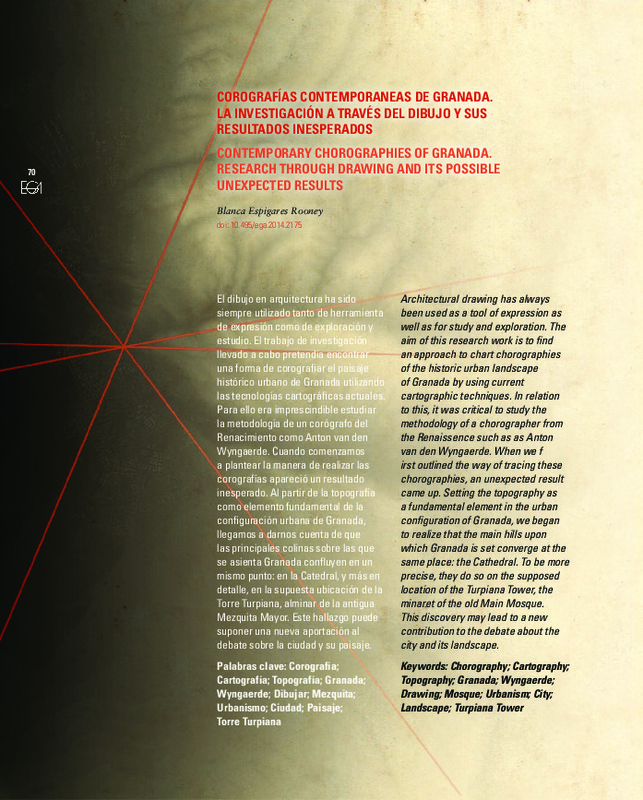JavaScript is disabled for your browser. Some features of this site may not work without it.
Buscar en RiuNet
Listar
Mi cuenta
Estadísticas
Ayuda RiuNet
Admin. UPV
Corografías contemporáneas de granada. La investigación a través del dibujo y sus resultados inesperados
Mostrar el registro sencillo del ítem
Ficheros en el ítem
| dc.contributor.author | Espigares Rooney, Blanca
|
es_ES |
| dc.coverage.spatial | east=-3.5985570999999936; north=37.1773363; name= Granada, Espanya | |
| dc.date.accessioned | 2016-12-28T09:10:35Z | |
| dc.date.available | 2016-12-28T09:10:35Z | |
| dc.date.issued | 2014-05-15 | |
| dc.identifier.issn | 1133-6137 | |
| dc.identifier.uri | http://hdl.handle.net/10251/75852 | |
| dc.description.abstract | [EN] Architectural drawing has always been used as a tool of expression as well as for study and exploration. The aim of this research work is to find an approach to chart chorographies of the historic urban landscape of Granada by using current cartographic techniques. In relation to this, it was critical to study the methodology of a chorographer from the Renaissence such as as Anton van den Wyngaerde. When we f irst outlined the way of tracing these chorographies, an unexpected result came up. Setting the topography as a fundamental element in the urban configuration of Granada, we began to realize that the main hills upon which Granada is set converge at the same place: the Cathedral. To be more precise, they do so on the supposed location of the Turpiana Tower, the minaret of the old Main Mosque. This discovery may lead to a new contribution to the debate about the city and its landscape | es_ES |
| dc.description.abstract | [ES] El dibujo en arquitectura ha sido siempre utilizado tanto de herramienta de expresión como de exploración y estudio. El trabajo de investigación llevado a cabo pretendía encontrar una forma de corografiar el paisaje histórico urbano de Granada utilizando las tecnologías cartográficas actuales. Para ello era imprescindible estudiarla metodología de un corógrafo del Renacimiento como Anton van den Wyngaerde. Cuando comenzamos a plantear la manera de realizar las corografías apareció un resultado inesperado. Al partir de la topografía como elemento fundamental de la configuración urbana de Granada, llegamos a darnos cuenta de que las principales colinas sobre las que se asienta Granada confluyen en un mismo punto: en la Catedral, y más en detalle, en la supuesta ubicación de la Torre Turpiana, alminar de la antigua Mezquita Mayor. Este hallazgo puede suponer una nueva aportación al debate sobre la ciudad y su paisaje | es_ES |
| dc.language | Español | es_ES |
| dc.language | Inglés | es_ES |
| dc.publisher | Universitat Politècnica de València | |
| dc.relation.ispartof | EGA. Revista de Expresión Gráfica Arquitectónica | |
| dc.rights | Reserva de todos los derechos | es_ES |
| dc.subject | Turpiana Tower | es_ES |
| dc.subject | Landscape | es_ES |
| dc.subject | City | es_ES |
| dc.subject | Urbanism | es_ES |
| dc.subject | Mosque | es_ES |
| dc.subject | Drawing | es_ES |
| dc.subject | Granada, Andalusia | es_ES |
| dc.subject | Cartography | es_ES |
| dc.subject | Cartografía | es_ES |
| dc.subject | Topografía | es_ES |
| dc.subject | Granada, Andalucía | es_ES |
| dc.subject | Wyngaerde | es_ES |
| dc.subject | Dibujar | es_ES |
| dc.subject | Mezquita | es_ES |
| dc.subject | Urbanismo | es_ES |
| dc.subject | Ciudad | es_ES |
| dc.subject | Paisaje | es_ES |
| dc.subject | Torre Turpiana | es_ES |
| dc.subject | Topography | es_ES |
| dc.subject | Corografía | es_ES |
| dc.subject | Corography | es_ES |
| dc.title | Corografías contemporáneas de granada. La investigación a través del dibujo y sus resultados inesperados | es_ES |
| dc.title.alternative | CONTEMPORARY CHOROGRAPHIES OF GRANADA. RESEARCH THROUGH DRAWING AND ITS POSSIBLE UNEXPECTED RESULTS Contemporary chorographies of Granada. Research through drawing and its possible unexpected results | es_ES |
| dc.type | Artículo | es_ES |
| dc.date.updated | 2016-12-23T13:26:29Z | |
| dc.identifier.doi | 10.4995/ega.2014.2175 | |
| dc.rights.accessRights | Abierto | es_ES |
| dc.description.bibliographicCitation | Espigares Rooney, B. (2014). Corografías contemporáneas de granada. La investigación a través del dibujo y sus resultados inesperados. EGA. Revista de Expresión Gráfica Arquitectónica. 19(23):70-79. https://doi.org/10.4995/ega.2014.2175 | es_ES |
| dc.description.accrualMethod | SWORD | es_ES |
| dc.relation.publisherversion | https://doi.org/10.4995/ega.2014.2175 | es_ES |
| dc.description.upvformatpinicio | 70 | es_ES |
| dc.description.upvformatpfin | 79 | es_ES |
| dc.type.version | info:eu-repo/semantics/publishedVersion | es_ES |
| dc.description.volume | 19 | |
| dc.description.issue | 23 | |
| dc.identifier.eissn | 2254-6103 | |
| dc.description.references | – MARTÍN, E.L., 1983. "Los grandes conjuntos regionales", Geografía de la sociedad humana: Los grandes conjuntos geográficos. Planeta. | es_ES |








